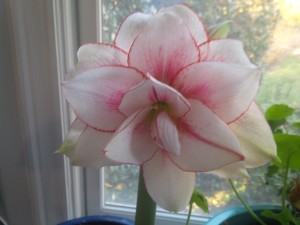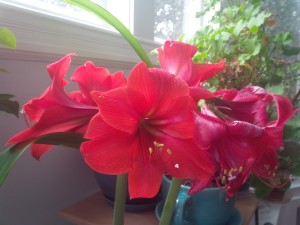

Nine chances out of ten, if you are reading this, you have an amaryllis in the house. Maybe it arrived ready to bloom just before the December holidays. If so, you may still be enjoying the last of the bright flowers. Or it might have come to you as a kit. If you followed the package directions and planted the bulb, the flowers will burst forth a few weeks from now. Amaryllis is so easy to grow that even confirmed “black thumbs” can feel the full flush of horticultural success as the stalks soar towards the ceiling.
When I give amaryllis as gifts every holiday season, I order bulbs in bulk, pot them up and send them on their way with ribbons around the pots. Each large bulb is primed to sprout, with at least an inch or two of pointed bud already emerging from the top. Given a bit of light and water, they will grow as if primed with rocket fuel, bursting into bloom right around the time when the recipients will be heartily sick of winter. There is nothing like a giant, sassy floral trumpet to blast away the malaise.
Known by the Latin name Hippeastrum, winter blooming amaryllis is a member of the Amaryllidaceae plant family. One of its kin is belladonna lily, a plant with similar lily-like blooms that goes by the Latin—but not common–name “Amaryllis”. If the amaryllis/belladonna distinction seems too confusing, don’t worry. The plant that adorns your house in winter is definitely Hippeastrum.
Once upon a time, maybe fifty years ago, poinsettias were the sine qua non of holiday decorating and the only commercially available amaryllis were either bright red or white. The flowers bloomed atop tall stalks, producing large, single blooms. Each bulb generally bore two flower stalks for a total of eight blooms per season. Afterwards the bulbs put their energies into long, strap-shaped leaves. Some amaryllis lovers cosseted the bulbs year-round, inducing dormancy at the end of each summer in the hopes of stimulating repeat bloom.
You can still can single, red or white-flowering amaryllis, but over the decades, breeders have gone to town with these exuberant plants. There are no blue or blue-purple varieties yet, but just about every other part of the color spectrum is represented. Fluffy flower lovers can rejoice at opulent doubles like white-flowered ‘Alfresco’, while minimalists may find inspiration in the spidery petals of cybister types, like the pink and green ‘Emerald’. Papilio or “butterfly” amaryllis resemble exotic orchids striped in maroon, green and cream.
And just as some amaryllis have been super-sized, others have shrunk. Traditional amaryllis produce 14 to 18-inch stems that sometimes need staking. Some of the miniature varieties feature slightly smaller trumpets on more manageable, 13-inch stems.
And if plopping your amaryllis bulb in a bit of soil or forcing the bulb over a container of pebbles and water is too much trouble, you can buy waxed bulbs, which require no care at all. The thin coat of wax applied to these amaryllis prior to shipping seals the bulbs, so they cannot take up water and nutrients. This is fine the first year, because amaryllis, like many bulbs, are self sufficient, with enough stored energy to sustain the plant through the first bloom period. However, the wax coat also means that your amaryllis will be unable to support itself once the flowers fade. If you buy or receive waxed amaryllis, the fact will be clearly noted on the packaging. After the petals fade, throw the bulb on the compost pile and don’t feel guilty.
Amaryllis has also gained traction as a cut flower, used in arrangements just like conventional lilies, but without the pervasive sweet scent. If even the waxed bulbs are too much trouble, your local florist can probably supply you with cut amaryllis, which go nicely with seasonal greens. I have even seen wreathes bedecked with the big blooms, their shortened stems positioned in cleverly concealed, water-filled florist’s tubes.
So even if your tolerance for indoor plant care is miniscule, the world of available amaryllis is large. Snap some up at the post-holiday sales. I guarantee that the rigors of January and February will be more bearable with a bit of floral brightness close at hand.
